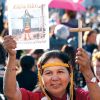St. Kateri the ‘protectress of Canada’
VATICAN CITY - Calling Kateri Tekakwitha the “protectress of Canada,” Pope Benedict XVI canonized her along with six others at an Oct. 21 ceremony in St. Peter’s Square.
The Catholic Church’s seven new saints are examples to the world of total dedication to Christ and tireless service to others, said Pope Benedict XVI.
An estimated 80,000 pilgrims filled St. Peter’s Square for the canonization of the holy women and men who ministered among their people. The pilgrims applauded the proclamation of the new saints — Kateri Tekakwitha, Mother Marianne Cope, Pedro Calungsod, Jacques Berthieu, Giovanni Battista Piamarta, Carmen Salles Barangueras and Anna Schaffer.
In his homily at Mass following the canonization, Pope Benedict prayed that the example of the new saints would “speak today to the whole Church” and that their intercession would strengthen the Church in its mission to proclaim the Gospel to the world.
The Pope also spoke about each new saint individually, giving a short biographical outline and highlighting a special characteristic of each for Catholics today.
Pope Benedict entrusted to St. Kateri “the renewal of the faith in the First Nations and in all of North America.” The daughter of a Mohawk father and Algonquin Christian mother, St. Kateri was “faithful to the traditions of her people,” but also faithful to the Christianity she embraced at age 20. She is the first North American aboriginal saint.
“May her example help us to live where we are, loving Jesus without denying who we are.”
Archbishop Charles Chaput of Philadelphia, who is of American Indian descent, told Catholic News Service, “I think many young people today are embarrassed about embracing the Catholic faith because they live in a secular culture that’s hostile toward religious experience.” St. Kateri also “grew up in a place where there was great hostility toward Christianity,” Chaput said, but she resisted all efforts to turn her away from her faith, “so in some ways she would be a model of fidelity in the face of persecution on religious freedom grounds.”
Archbishop Gerald Cyprien Lacroix of Quebec told CNS that the canonization of the first aboriginal of North America is “huge for us.” St. Kateri, he said, is an excellent model for young people of “living a simple life, faithful to the Lord in the midst of hostility.” St. Kateri’s life and canonization show that “saints don’t have to do extraordinary things, they just have to love,” Lacroix said.
Francine Merasty, 32, a Cree who lives in Pelican Narrows, Sask., said, “Kateri inspires me because she’s an aboriginal woman. According to sociologists, aboriginal women are at the lowest (social) strata, and for the Church to raise up to the communion of saints an aboriginal woman is so awesome and wonderful.”
Phil Fontaine, former national chief of the Assembly of First Nations of Canada, told Canadian Church and government officials the canonization “makes it possible, very much possible, to bring our community — the First Nations — very much closer with the Catholic Church. There was a rupture for too long.”
After decades of resentment and horror over the abuse of indigenous children, the canonization of St. Kateri Tekakwitha marked a further step toward the reconciliation of the indigenous communities and the Catholic Church, he said.
Fontaine headed a 2009 Canadian aboriginal delegation to the Vatican, which received a formal apology from the Church for the treatment of native children in Canadian residential schools. An estimated 100,000 aboriginal children passed through the schools, which were abolished in the 1990s. They were established and paid for by the Canadian government, but were administered by various Church organizations, including Roman Catholic dioceses and religious orders. The schools became known for widespread physical and sexual abuse of children and have been blamed for contributing to the disappearance of native languages and cultures.
“If you link the two events” — the 2009 meeting and the canonization — “it is all about imparting reconciliation,” Fontaine said.
The canonization, he said, “is an opportunity for us to say, ‘We accept your apology, we forgive, and so now let us begin taking the important steps of healing and reconciliation.’ ”

